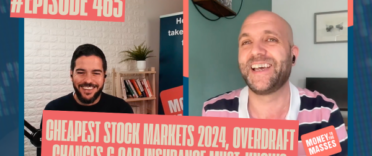The 134th episode of my weekly YouTube show where I discuss what is happening in investment markets and what to look out for. This week I explain how and why tech stocks have tanked in the New Year.
Each show lasts between 5-10 minutes and is aimed at DIY investors (including novices) seeking contemporary analysis to help them understand how investment markets work.
Subscribe to my YouTube channel to receive my weekly analysis of investment markets or alternatively, you can listen via my weekly Midweek Markets podcast below.
Midweek Markets weekly podcast
Other ways to watch, listen and subscribe
You can listen to other episodes and subscribe to the show by searching 'Money to the Masses' on Spotify or by using the following links:
Abridged transcript - Midweek Markets episode 134
This is the first show of 2022 and Happy New Year! So just to recap where I left you before Christmas it was with the reminder that despite the market wobbles that we’d experienced in December that the uptrend in US stock remained as it did in UK stocks. Japanese equities were trending sideways while the UK pound continued to struggle but was giving a currency boost to any overseas holdings in your portfolio.
In the interim I also said to watch the levels of 4700 & 4500 on the S&P 500 and that a convincing move above 4700 would likely spur a move higher, while a move below 4500 could see equity markets unravel. Similarly, the 1.4% level on the 10 year US treasury yield was key, if we tumbled below that then equity markets were likely to come under pressure as investors flocked to bonds.
So what’s transpired since the last show? Well, true to form the Santa rally came to town continuing its amazing level of historic consistency. On the 23rd December the S&P 500 broke above 4700 and by the end of the year had breached 4800, setting new all-time highs along the way. Technical analysis is great when you get it right. It meant that the S&P 500 returned 4.36% in December.
But the euphoria was matched globally and even bettered in some regions. European stocks finished December up 5.47% as measured by the Eurofirst 300. The FTSE 100 rose 4.6% while the MSCI ACWI rose 3.6%. Even emerging markets and Asian equities which were the laggards in December rose 1.22% and 0.88% respectively, as measured by the MSCI Emerging Markets and the MSCI AC Asia ex-Japan indices.
Interestingly also among the laggards was the tech-heavy Nasdaq 100 which finished December up 1.14% as bond yields started to creep up in the anticipation of policy tightening by the US Federal Reserve (the Fed). The 10 year US treasury yield rose back above 1.5%, which was good news for stocks.
It meant that we experienced the best Santa Rally for the S&P 500 since the financial crisis while in the UK it was the best December since 2016. That’s how good December was, and those who didn’t keep their heads and panicked during the bouts of market volatility missed out.
Interestingly the winners and laggards were almost the exact reverse of the previous December in 2020, when the Nasdaq 100 and emerging markets finished up over 5%, while the Dow Jones, European stocks and the FTSE 100 lagged but still rallied 2-3%. The contrast in fortunes is down to what was driving markets this year versus last year. Into the year-end of 2020 we had new hope surrounding the newly created vaccines alongside continued easy monetary policy from central banks. But this year with vaccines having been rolled out globally, the focus was on the new Omicron variant and the tightening of monetary policy by global central banks. In the lead up to Christmas I reiterated how more certainty on both of these themes would dictate much about how markets will move in 2022.
No sooner had we begun January, we immediately had more clarity on both topics. The consensus among health officials and governments seems to be that while Omicron is of serious concern and highly contagious, its hospitalisation rate is lower than feared. In the UK for example the government is clearly taking a “wait and see” approach, or you could call it a “do-nothing approach”. In addition, the US Federal Reserve released the minutes from its pre-Xmas monetary policy meeting on Wednesday. Some central banks including the Bank of England release their minutes at the same time as their decision, but not the Fed.
The immediate reaction to the Fed minutes was violent as they suggested that the Fed will likely taper QE but also raise interest rates faster than had been anticipated. European stock markets were closed at the time of the release but US markets were open. Immediately we saw the Nasdaq 100 fall 3.3% for the day, while the S&P 500 finished down almost 2% dragged lower by exposure to tech stocks. The more cyclically exposed Dow Jones fell just 1%.
The market has only reacted more strongly to the release of Fed minutes on 3 occasions since 2007. That gives the move much-needed context. The combination of a more aggressive Fed (meaning higher rates) and the optimism over the path of Omicron and the pandemic is seen as a toxic combination for tech stocks. Don’t forget that higher rates are usually bad for tech stock share prices as the future profits of these companies (some of which have yet to become profitable) are off in the future. Higher interest rates mean that when these profits are discounted back today (which influences the price of the companies’ shares) these earnings are less attractive. This puts downward pressure on the share price of tech stocks, which no longer had the support of being defensive plays during a pandemic given the consensus on Omicron. It was back to fundamentals and the valuation of these stocks, whose future earnings were viewed less optimistically, tumbled.
We have well and truly gone back to the reflation trade in a very aggressive way. Unsurprisingly bond yields spiked higher. The 10 year US treasury yield exploded above 1.7%, and it will be interesting to see if it breaks above the post-pandemic high of 1.778%.
It means that if you had a portfolio based around bonds and growth stocks you will be licking your wounds so far in 2022. But if you instead had a low bond exposure and favoured reflation stocks such as financials, energy stocks and industrial names you will have fared well. 80-20 Investor members should look at my research piece on funds for the reflation trade to see what assets have previously performed well during such periods and which have performed badly.
The question then becomes can the reflation trade carry the market higher, or will the sell-off in big tech names such as Apple spook investors and bleed over into other areas of the market? It’s only the early days of 2022 and a lot is happening but there are still plenty of questions that need answering. Is 2022 the year where finally the reflation trade takes hold? Has inflation already started to peak and will we see a reversal? Will commodities continue their rebound from November’s low or will a stubbornly strong US dollar spoil the recovery? Will the growth stocks underperform value stocks finally, and therefore give a chance for other global stocks markets to outshine the US? Also when do higher bond yields start to become a problem for stock markets? All I can say is that if the start of 2022 is anything to go by then this year is unlikely to be dull.



